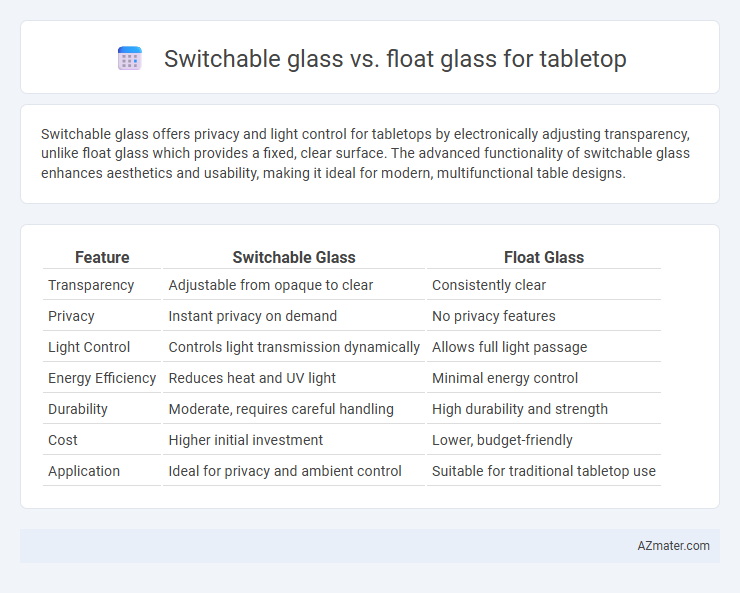Switchable glass offers privacy and light control for tabletops by electronically adjusting transparency, unlike float glass which provides a fixed, clear surface. The advanced functionality of switchable glass enhances aesthetics and usability, making it ideal for modern, multifunctional table designs.
Table of Comparison
| Feature | Switchable Glass | Float Glass |
|---|---|---|
| Transparency | Adjustable from opaque to clear | Consistently clear |
| Privacy | Instant privacy on demand | No privacy features |
| Light Control | Controls light transmission dynamically | Allows full light passage |
| Energy Efficiency | Reduces heat and UV light | Minimal energy control |
| Durability | Moderate, requires careful handling | High durability and strength |
| Cost | Higher initial investment | Lower, budget-friendly |
| Application | Ideal for privacy and ambient control | Suitable for traditional tabletop use |
Introduction to Switchable Glass and Float Glass
Switchable glass, also known as smart glass, incorporates liquid crystal technology that allows transparency to be altered from opaque to clear with an electric current, enhancing privacy and aesthetic flexibility in tabletops. Float glass, produced by floating molten glass on a bed of molten metal, offers uniform thickness and clarity but lacks the adaptive features of switchable glass. Choosing between switchable and float glass for tabletops involves considering functionality, with switchable glass providing dynamic light control and float glass delivering cost-effective optical quality.
How Switchable Glass Works
Switchable glass, also known as smart glass, utilizes a polymer dispersed liquid crystal (PDLC) film sandwiched between two glass panels that changes opacity when an electric current passes through it, allowing it to switch from transparent to opaque. In contrast, float glass is a standard, flat glass made by floating molten glass on a bed of molten metal, offering clear visibility without any light-switching properties. The electric control in switchable glass enables privacy and light regulation for tabletops, making it a functional and modern alternative to conventional float glass.
Float Glass: Composition and Characteristics
Float glass, composed primarily of silica sand, soda ash, and limestone, offers a smooth, optically clear surface ideal for tabletops. Its uniform thickness and high durability make it resistant to scratches and impacts in everyday use. Unlike switchable glass, float glass lacks integrated smart technology but provides superior clarity and a cost-effective solution for elegant table surfaces.
Aesthetic Differences Between Switchable and Float Glass
Switchable glass features dynamic transparency that shifts from opaque to clear with electric activation, offering a modern, sleek aesthetic ideal for contemporary tabletops. Float glass maintains a consistent clarity and smooth surface, providing a classic, minimalist look that enhances natural light reflection. The ability of switchable glass to control privacy and light creates a versatile visual appeal, while float glass offers timeless simplicity and uninterrupted views.
Comparative Durability and Strength
Switchable glass offers enhanced durability compared to float glass due to its laminated structure with embedded liquid crystal layers, which provide additional impact resistance and prevent shattering. Float glass, while commonly used for tabletops, is more prone to cracking and breakage under stress due to its single glass panel design. The superior strength and safety features of switchable glass make it a preferable choice for high-traffic or multifunctional tabletop applications.
Privacy and Light Control Features
Switchable glass offers advanced privacy by instantly changing from transparent to opaque with electric activation, allowing precise control over visibility on tabletops. Float glass, being uniformly clear and untreated, provides no privacy benefits but allows maximum natural light transmission without altering clarity. For tabletop applications requiring dynamic light control and confidentiality, switchable glass delivers superior functionality compared to traditional float glass.
Safety Considerations for Tabletop Use
Switchable glass offers enhanced safety for tabletops with its ability to transition from opaque to transparent, providing privacy without sacrificing strength, often manufactured with laminated or tempered layers to resist shattering. Float glass, while commonly used in tabletops, lacks built-in safety features and is prone to sharp breakage upon impact unless treated with additional safety coatings or laminates. For high-traffic or family environments, switchable glass is preferable due to its controlled breakage properties and compliance with safety standards such as ANSI Z97.1 or EN 12150, reducing injury risks.
Maintenance and Cleaning Requirements
Switchable glass requires specialized maintenance to preserve its liquid crystal technology, including avoiding abrasive cleaners and using a soft cloth with mild detergent to prevent damage to the film. Float glass is simpler to clean, tolerating standard household glass cleaners without risk, making it low-maintenance for tabletops. Consistent care with switchable glass ensures its opacity function remains effective, while float glass prioritizes ease of upkeep and durability.
Cost Comparison and Value
Switchable glass typically costs significantly more than float glass, with prices ranging from $120 to $250 per square meter compared to float glass at approximately $30 to $60 per square meter. Although switchable glass offers advanced features like privacy control and dynamic light modulation, its higher upfront cost may impact overall project budget. Float glass remains a cost-effective choice for tabletops where basic transparency and durability are sufficient, providing greater value for standard applications.
Choosing the Right Glass for Your Tabletop Needs
Switchable glass offers privacy and modern aesthetics by transforming from transparent to opaque with an electric current, ideal for multifunctional tabletops in offices or homes. Float glass provides a clear, durable, and cost-effective option suitable for standard tabletops, emphasizing clarity and strength without changing transparency. Selecting between switchable and float glass depends on desired functionality, budget constraints, and design preferences to ensure optimal tabletop performance.

Infographic: Switchable glass vs Float glass for Tabletop
 azmater.com
azmater.com